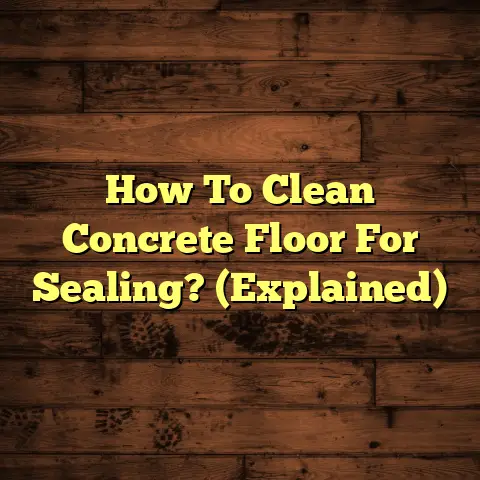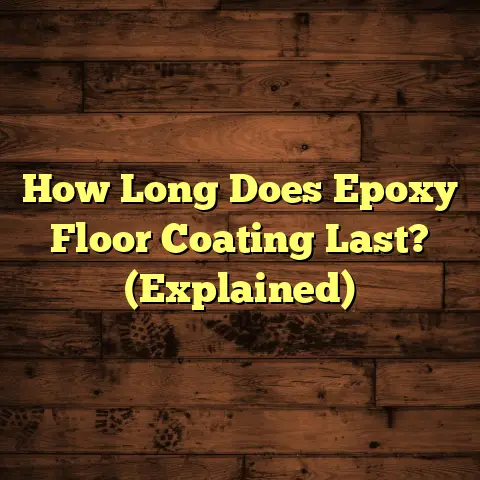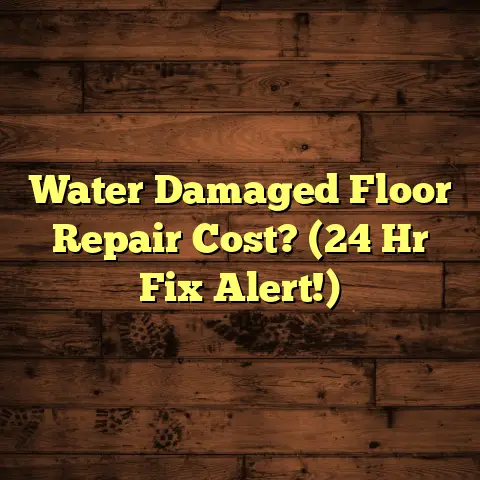Measure Moisture In Concrete Floors? (3 Tools to Use!)
We’re talking about bubbling adhesives, mold growth, and flooring failures. It’s not pretty, and it’s definitely something you want to avoid.
Concrete is super popular, right? Easy to clean – a quick sweep and mop, and you’re done. Plus, it looks great in modern homes and stores.
But here’s the thing: concrete can be a sneaky sponge. If moisture gets trapped, it can wreck your flooring.
That’s why measuring moisture is so important.
In this article, I’m going to break down why moisture is a big deal and show you the three tools I use to measure it. Let’s dive in!
Understanding Moisture in Concrete
Okay, so what exactly is moisture content in concrete?
It’s the amount of water present in the concrete, expressed as a percentage.
Why does it matter? Well, concrete is porous. It can absorb moisture from different places:
- Ground moisture: Water seeping up from the soil below.
- Humidity: Moisture in the air.
- Water intrusion: Leaks from rain, plumbing, etc.
Excess moisture is a recipe for disaster. It can lead to:
- Mold growth: Unhealthy and smelly.
- Structural damage: Weakening the concrete.
- Flooring failure: Adhesives fail, causing bubbling or warping.
I remember one job where a homeowner installed hardwood floors over concrete without checking the moisture. Within months, the floors started cupping and buckling.
We had to rip everything out and start over. Costly mistake!
The Importance of Measuring Moisture
Before you even think about installing new flooring over concrete, you need to measure the moisture levels.
Why? Because high moisture can mess with your flooring big time.
It can affect which flooring you choose and how you install it. Some adhesives won’t bond properly if the concrete is too damp.
And trust me, you don’t want to find out the hard way that your flooring is failing due to moisture.
Did you know that moisture-related flooring failures are more common than you might think?
The Portland Cement Association estimates that up to 20% of all flooring failures are due to excessive moisture in concrete slabs [https://www.cement.org/].
That’s a huge number!
Taking the time to measure moisture can save you a lot of money and headaches down the road.
Overview of Tools for Measuring Moisture
Alright, let’s talk tools. There are three main ways I measure moisture in concrete:
- Moisture Meters: Quick and easy for surface readings.
- Calcium Chloride Test: Measures moisture emission rate.
- Relative Humidity (RH) Testing: Measures humidity inside the concrete.
Each tool has its pros and cons, and I’ll walk you through how they work.
But here’s the deal: no single tool is perfect for every situation.
Sometimes, I use a combination of methods to get a complete picture of the moisture levels.
Tool 1 – Moisture Meters
Let’s start with moisture meters. These are handheld devices that give you a quick reading of the moisture content in concrete.
They work by measuring the electrical resistance or capacitance of the concrete.
Moisture conducts electricity, so the more moisture, the lower the resistance.
There are two main types of moisture meters:
- Pin-type: These have two pins that you insert into the concrete. They measure the resistance between the pins.
- Pinless: These use a sensor pad that you place on the surface of the concrete. They measure the capacitance of the concrete.
I personally prefer pinless meters because they don’t leave holes in the concrete.
But pin-type meters can be more accurate in certain situations.
How to Use a Moisture Meter:
- Calibrate the meter: Follow the manufacturer’s instructions to calibrate the meter before each use.
- Prepare the surface: Clean the concrete surface and remove any debris.
- Take readings: Place the meter on the surface and take several readings in different areas.
- Record the readings: Write down the readings and note the location where you took them.
Interpreting the Readings:
The acceptable moisture level depends on the type of flooring you’re installing.
Here’s a general guideline:
- Hardwood: Below 6% moisture content
- Laminate: Below 4% moisture content
- Vinyl: Below 5% moisture content
Always check the flooring manufacturer’s recommendations for specific moisture requirements.
Tips for Using Moisture Meters:
- Take multiple readings in different areas of the slab.
- Avoid taking readings near walls or cracks.
- Be aware that surface readings may not reflect the moisture content deeper in the slab.
- Always follow the manufacturer’s instructions for your specific meter.
I find moisture meters super handy for quick checks. But remember, they only give you a surface reading. For a more accurate assessment, you’ll need to use other methods.
Tool 2 – Calcium Chloride Test
The calcium chloride test, also known as the anhydrous calcium chloride test, measures the moisture emission rate (MER) from the concrete slab.
In simple terms, it tells you how much moisture is evaporating from the concrete over a 24-hour period.
This test is considered a reliable method for determining if a concrete slab is dry enough for flooring installation.
Materials Needed:
- Anhydrous calcium chloride
- Airtight container
- Scale
- Tape
- Hygrometer (optional)
Testing Procedure:
- Prepare the surface: Clean the concrete surface and remove any debris.
- Weigh the calcium chloride: Accurately weigh a specific amount of anhydrous calcium chloride (usually around 25-50 grams).
- Place the calcium chloride: Put the calcium chloride in the airtight container and place it on the prepared concrete surface.
- Seal the container: Seal the container to the concrete surface using tape.
- Wait 60-72 hours: Leave the container in place for 60-72 hours to allow the calcium chloride to absorb moisture.
- Weigh the calcium chloride again: After the waiting period, carefully remove the container and weigh the calcium chloride again.
- Calculate the moisture emission rate: Calculate the difference in weight and use a formula to determine the moisture emission rate (pounds per 1000 square feet per 24 hours).
Analyzing the Results:
The acceptable moisture emission rate depends on the type of flooring you’re installing.
Here’s a general guideline:
- Hardwood: Below 3 lbs/1000 sq ft/24 hours
- Laminate: Below 5 lbs/1000 sq ft/24 hours
- Vinyl: Below 5 lbs/1000 sq ft/24 hours
Again, always check the flooring manufacturer’s recommendations.
Advantages and Disadvantages:
- Advantages: Relatively inexpensive, provides a good indication of moisture emission rate.
- Disadvantages: Requires a 60-72 hour waiting period, can be affected by ambient conditions.
I’ve used the calcium chloride test on many jobs, especially when dealing with moisture-sensitive flooring like hardwood. It gives me a good sense of how much moisture is coming out of the slab.
Tool 3 – Relative Humidity Testing
Relative humidity (RH) testing is another way to measure moisture in concrete.
Instead of measuring moisture content or emission rate, it measures the humidity inside the concrete slab.
This method is based on the principle that the RH within the concrete is in equilibrium with the moisture content.
In-Situ Probes:
RH testing uses in-situ probes that are inserted into holes drilled into the concrete slab.
These probes measure the RH at a specific depth within the concrete.
Testing Procedure:
- Drill holes: Drill holes into the concrete slab to the required depth (usually 40% of the slab thickness).
- Insert probes: Insert the RH probes into the holes.
- Seal the holes: Seal the holes around the probes to prevent ambient air from affecting the readings.
- Wait 24-72 hours: Allow the probes to equilibrate with the moisture in the concrete.
- Take readings: Use a handheld meter to read the RH from the probes.
Interpreting the Results:
The acceptable RH level depends on the type of flooring you’re installing.
Here’s a general guideline:
- Hardwood: Below 75% RH
- Laminate: Below 85% RH
- Vinyl: Below 85% RH
As always, check the flooring manufacturer’s recommendations.
Advantages and Disadvantages:
- Advantages: Provides a more accurate assessment of moisture conditions within the slab, less affected by ambient conditions.
- Disadvantages: More expensive than other methods, requires drilling holes in the concrete.
I’ve found RH testing to be the most reliable method for assessing moisture in concrete, especially for thicker slabs. It gives me a clear picture of what’s going on inside the concrete.
Comparison of Tools
Okay, let’s compare the three tools we’ve discussed:
| Tool | Accuracy | Ease of Use | Cost | Time Required |
|---|---|---|---|---|
| Moisture Meter | Low-Moderate | High | Low | Immediate |
| Calcium Chloride Test | Moderate | Moderate | Moderate | 72 hours |
| RH Testing | High | Moderate | High | 24-72 hours |
When to Use Which Tool:
- Moisture Meter: Use for quick checks and surface readings.
- Calcium Chloride Test: Use for a good indication of moisture emission rate, especially for moisture-sensitive flooring.
- RH Testing: Use for the most accurate assessment of moisture conditions within the slab, especially for thicker slabs.
Combining Methods:
I often combine these methods to get a more complete picture of the moisture levels in concrete.
For example, I might use a moisture meter for a quick initial assessment, then follow up with an RH test to get a more accurate reading.
Conclusion
Measuring moisture in concrete floors is crucial for ensuring the longevity and performance of your flooring installation.
Using the right tools and methods can prevent costly repairs and headaches down the road.
Don’t skip this step! Take the time to assess your concrete flooring conditions proactively.
By understanding the moisture levels in your concrete, you can make informed decisions about flooring choices and installation methods.
This will help you avoid moisture-related flooring failures and ensure that your floors look great and last for years to come.
So, grab those tools, get testing, and happy flooring!





